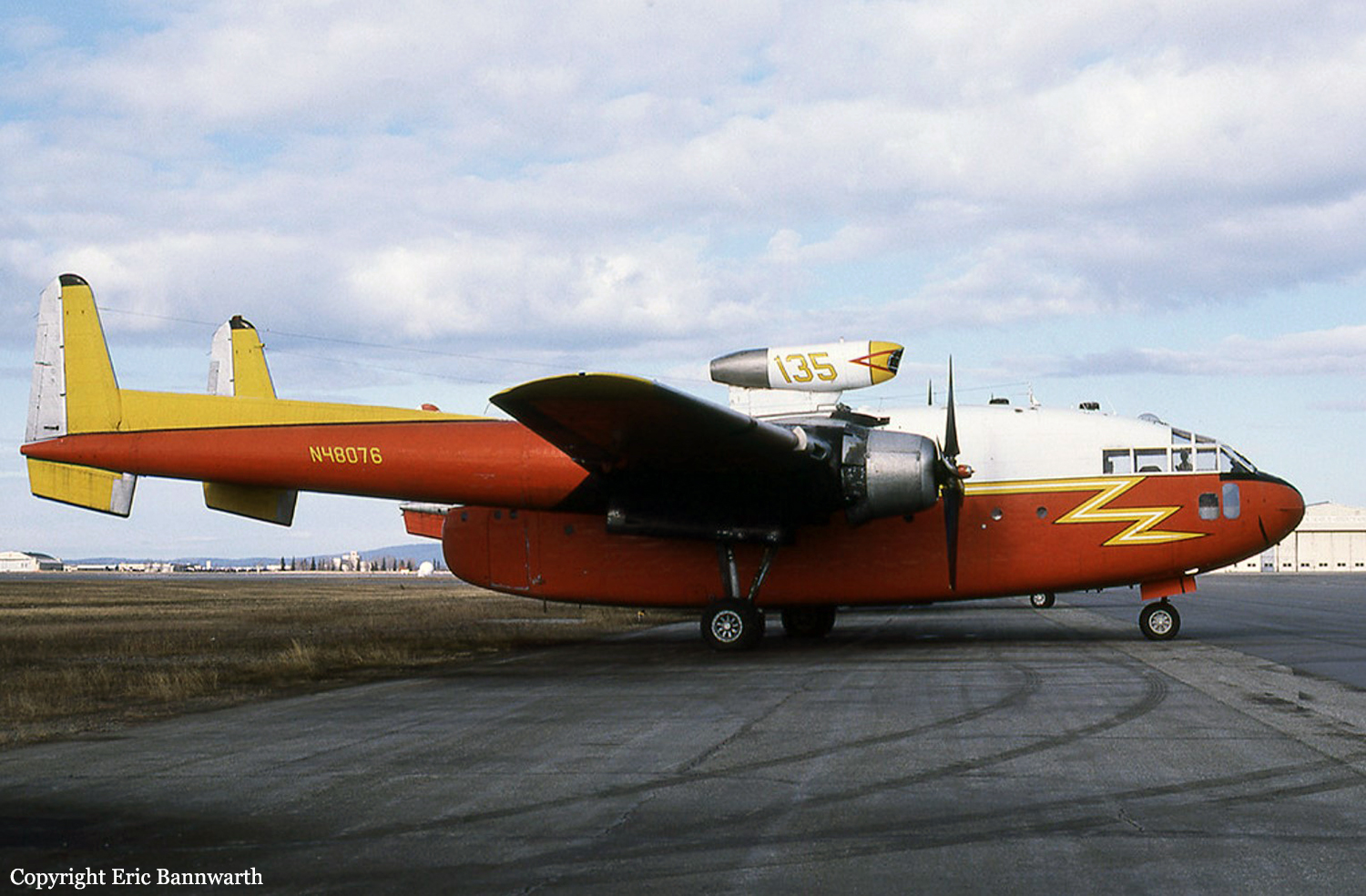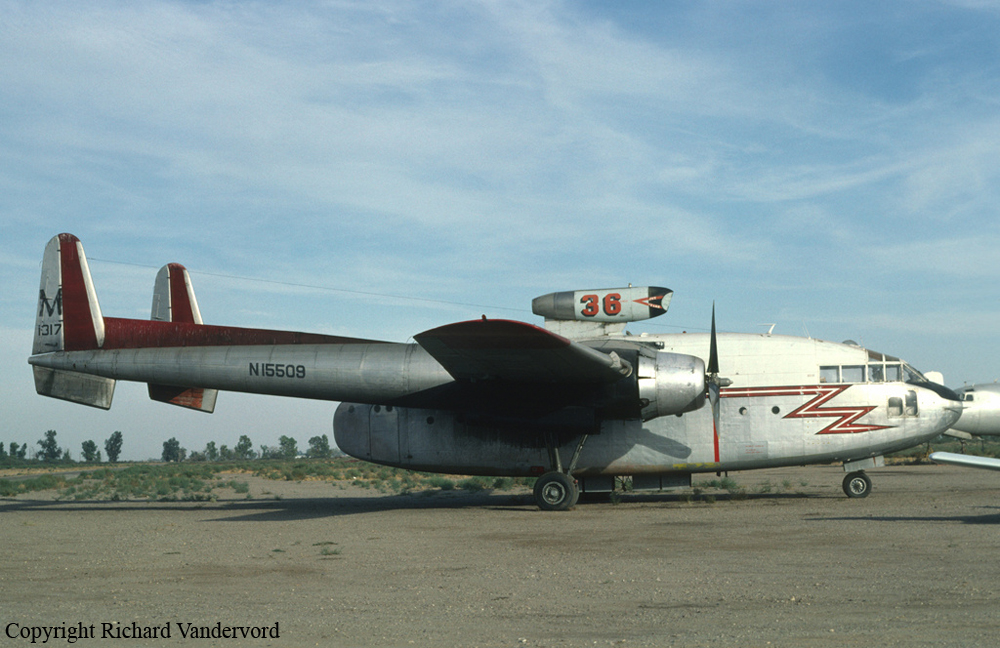Country
Crash of a Fairchild C-119G Flying Boxcar in Castle Crags State Park: 3 killed
Date & Time:
Sep 16, 1987 at 1730 LT
Registration:
N48076
Survivors:
No
Schedule:
Montague - Redding
MSN:
11005
YOM:
1952
Crew on board:
3
Crew fatalities:
Pax on board:
0
Pax fatalities:
Other fatalities:
Total fatalities:
3
Circumstances:
The Fairchild C-119G airtanker had been dispatched to a fire about six miles west of Castle Crags State Park, California at 17:05 and departed the Siskiyou County Airport, CA (SIY) shortly thereafter. N48076, another airtanker of the same kind, a leadplane, and an air attack arrived at the fire at the same time. Two more airtankers followed shortly thereafter. The leadplane identified the target, the approach and departure routes, indicated the target was at an elevation of 4,500 feet, that the ridge on final approach was to be crossed at 6,600 feet, advised there was no wind, there was good visibility, and that there was no turbulence except a "1.5g bump" going across the head of the fire. The leadplane directed one of the C-119 airtankers to drop first. That airtanker aborted their first run because of excess speed. On the second pass, it crossed the ridge at a different point, permitting a somewhat longer final approach. That drop was a successful one. The run was made through a saddle then down a creek to the fire some two miles down stream with a planned exit down stream into a larger canyon. The leadplane then directed the mishap C-119G airtanker to drop next. The mishap airtanker used the same approach as the first airtanker. The mishap airtanker reached the uphill side of the fire when the crew reported trouble maintaining proper speed and dropped their retardant on the fire. At about the time the pilot dropped the retardant, a structural failure occurred and the right wing separated from the airframe along with the tip of the left wing and the tail booms. The fuselage with both engines and most of the left wing attached encountered terrain impact and burned as a unit.
Source: https://www.fs.usda.gov/managing-land/fire
Source: https://www.fs.usda.gov/managing-land/fire
Probable cause:
In-flight loss of control following the structural failure of the right wing.

Crash of a Fairchild C-119L Flying Boxcar in Shageluk
Date & Time:
May 13, 1987 at 1900 LT
Registration:
N8504X
Survivors:
Yes
Schedule:
Anchorage - Shageluk
MSN:
245
YOM:
1947
Crew on board:
2
Crew fatalities:
Pax on board:
3
Pax fatalities:
Other fatalities:
Total fatalities:
0
Captain / Total hours on type:
36.00
Aircraft flight hours:
7982
Circumstances:
The airplane was destabilized by a slight vertical air movement on approach. The pilot touched the airplane down short of the runway proper, collapsing the landing gear before sliding off the strip into adjacent tundra. All five occupants escaped uninjured.
Probable cause:
Occurrence #1: undershoot
Phase of operation: landing - flare/touchdown
Findings
1. (f) weather condition - downdraft
2. (c) compensation for wind conditions - inadequate - pilot in command
3. (c) go-around - not performed - pilot in command
----------
Occurrence #2: gear collapsed
Phase of operation: landing - flare/touchdown
Findings
4. Landing gear, main gear - overload
5. Landing gear, main gear - failure, total
Phase of operation: landing - flare/touchdown
Findings
1. (f) weather condition - downdraft
2. (c) compensation for wind conditions - inadequate - pilot in command
3. (c) go-around - not performed - pilot in command
----------
Occurrence #2: gear collapsed
Phase of operation: landing - flare/touchdown
Findings
4. Landing gear, main gear - overload
5. Landing gear, main gear - failure, total
Final Report:
Crash of a Fairchild C-119G-FA Flying Boxcar in Venetie
Date & Time:
Apr 21, 1984 at 1730 LT
Registration:
N15509
Survivors:
Yes
Schedule:
Venetie - Fairbanks
MSN:
10775
YOM:
1953
Crew on board:
2
Crew fatalities:
Pax on board:
2
Pax fatalities:
Other fatalities:
Total fatalities:
0
Captain / Total hours on type:
3503.00
Aircraft flight hours:
8643
Circumstances:
The pilot was attempting a takeoff on an airstrip where braking action was considered good during the normal summer season. It was about 3,000 feet in elevation and was snow covered most of the year, as on the day of the accident. The strip accommodated takeoffs to the south only due to grading and obstructions. Frequently, this meant a downwind takeoff. On the day of the accident, there was a 5 knots wind from the north with gusts to 10 knots. The pilot said that nose wheel steering was not effective due to the surface and the rudder was not responsive due to the tailwind. Most pilots used a 25° (right turn) dogleg of the runway at the north end to start their takeoff, especially when tailwinds were present. The accident aircraft went off the runway to the left and collided with a snowbank where it nosed over. All four occupants escaped uninjured.
Probable cause:
Occurrence #1: on ground/water encounter with terrain/water
Phase of operation: takeoff - roll/run
Findings
1. (c) planning/decision - improper - pilot in command
2. (f) overconfidence in aircraft's ability - pilot in command
3. (f) self-induced pressure - pilot in command
4. (f) weather condition - high density altitude
5. (f) weather condition - tailwind
6. (f) airport facilities, runway/landing area condition - inadequate
7. (c) unsuitable terrain or takeoff/landing/taxi area - selected - pilot in command
8. (f) airport facilities, runway/landing area condition - snow covered
9. (f) airport facilities, runway/landing area condition - icy
10. (f) airport facilities, runway/landing area condition - rough/uneven
11. (f) terrain condition - snowbank
12. Proper alignment - not possible
----------
Occurrence #2: nose over
Phase of operation: takeoff
Phase of operation: takeoff - roll/run
Findings
1. (c) planning/decision - improper - pilot in command
2. (f) overconfidence in aircraft's ability - pilot in command
3. (f) self-induced pressure - pilot in command
4. (f) weather condition - high density altitude
5. (f) weather condition - tailwind
6. (f) airport facilities, runway/landing area condition - inadequate
7. (c) unsuitable terrain or takeoff/landing/taxi area - selected - pilot in command
8. (f) airport facilities, runway/landing area condition - snow covered
9. (f) airport facilities, runway/landing area condition - icy
10. (f) airport facilities, runway/landing area condition - rough/uneven
11. (f) terrain condition - snowbank
12. Proper alignment - not possible
----------
Occurrence #2: nose over
Phase of operation: takeoff
Final Report:

Crash of a Fairchild C-119G Flying Boxcar off Kinmen: 38 killed
Date & Time:
Jun 7, 1983 at 1240 LT
Registration:
3197
Survivors:
Yes
Schedule:
Kinmen - Taipei
Crew on board:
8
Crew fatalities:
Pax on board:
39
Pax fatalities:
Other fatalities:
Total fatalities:
38
Circumstances:
Shortly after takeoff from Kinmen-Shang Yi Airport (Quemoy Island), while climbing, the right engine caught fire. The aircraft lost height and crashed into the sea few hundred meters off shore. Nine occupants were rescued while 31 others were killed.
Probable cause:
Engine fire during initial climb for unknown reasons.

